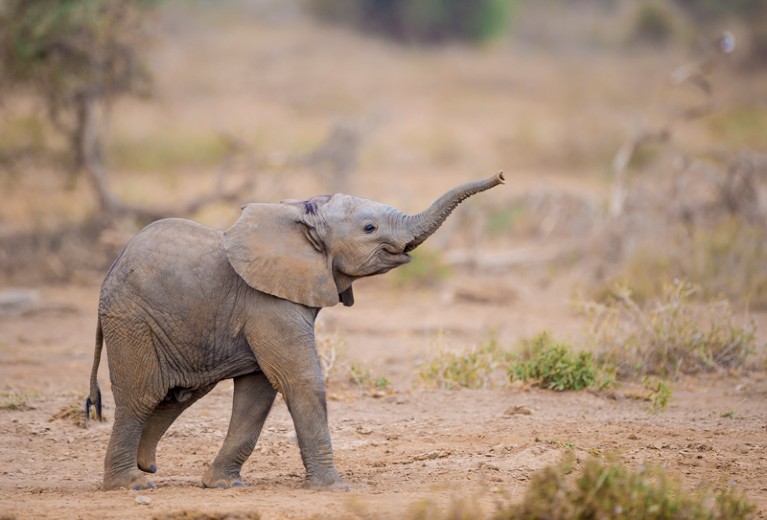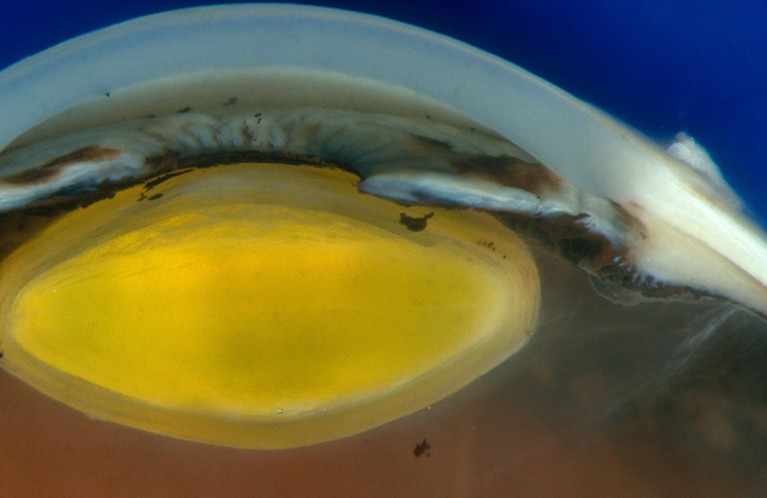POLICY
Ban on exporting baby elephants Tough new trade restrictions for dozens of wildlife species, including elephants, have been agreed at a meeting of parties to the Convention on International Trade in Endangered Species (CITES) in Geneva, Switzerland, which ended on 28 August. Nations voted to ban the practice of taking elephant calves from the wild and selling them to zoos overseas, and to allow the export of wild elephants only in exceptional circumstances. Countries also agreed to regulate trade in giraffes for the first time. Nine giraffe species will be protected under Appendix II of the convention, which protects species that could have faced extinction had trade restrictions not been implemented. Several species of turtle, lizard and gecko threatened by the trade in exotic pets, and 18 shark and ray species, were also added to Appendix II.

Trade in elephant calves has been restricted by the nations that are part of the endangered-species treaty CITES.Credit: Inaki Relanzon/NPL
Methane limits The US Environmental Protection Agency (EPA) wants to loosen federal limits on emissions of the greenhouse gas methane. A draft proposal released by the agency on 29 August would eliminate regulations that require oil and gas companies to monitor and limit methane leaks from wells, pipelines and storage facilities. In its proposal, the EPA also argues that it does not have the authority to regulate methane emissions under the Clean Air Act without first declaring the gas a pollutant — reversing its previous interpretation of the law. The agency says that the changes would save the oil and gas industry approximately US$17 million to $19 million a year. But several major energy companies, including ExxonMobil and BP, have urged the EPA to keep the current methane limits in place. The proposal will now undergo a 60-day public-comment period before the agency can issue a final version.
EVENTS
Longest space flight The US Air Force’s X-37B spaceplane set a record for long-duration space flight on 26 August, when it began its 719th day in orbit. The flight is the fifth by the uncrewed, solar-powered plane, which is nearly 9 metres long and looks like a miniature space shuttle. The X-37B traces its origins to a NASA research programme that began in 1999 and was moved to the US military in 2004. The air force flew its first X-37B in 2010 and has revealed little about the programme, other than to say that it is meant to demonstrate reusable spacecraft technologies such as flying autonomously, and to carry experiments in Earth’s orbit. Like the space shuttle, the X-37B launches vertically and lands horizontally. The four previous X-37B missions racked up 2,085 days in orbit between them; the fifth launched on 7 September 2017 from Cape Canaveral Air Force Station in Florida.
Nuclear explosion A small nuclear reactor is likely to have been involved in a mysterious blast at a Russian naval base on 8 August that killed five scientists and caused a short, unexplained spike in γ-radiation. Information has been slow to emerge about the event, but last week Russia’s weather agency, Roshydromet, finally revealed details about the nuclear radiation that was released. Rain and air samples contained strontium-91, barium-139, barium-140 and lanthanum-140 — radioactive isotopes created in the cores of reactors that produce energy by splitting uranium atoms in a chain reaction. These isotopes would have been released if the core of a reactor had exploded, nuclear scientists told Nature. The information lends weight to the theory that Russia was testing a nuclear-reactor-propelled missile known as Burevestnik, or Skyfall, which the country is known to be developing.
RESEARCH
Eye-cell transplant A Japanese woman in her forties has become the first person in the world to have her cornea repaired using reprogrammed stem cells. At a press conference on 29 August, ophthalmologist Kohji Nishida at Osaka University in Japan said that the woman has a disease in which the stem cells that repair the cornea (pictured), a transparent layer that covers and protects the eye, are lost. The condition makes vision blurry and can lead to blindness. To treat the woman, Nishida’s team created sheets of corneal cells from induced pluripotent stem cells. These are made by reprogramming adult skin cells from a donor into an embryonic-like state from which they can transform into other cell types, such as corneal cells. Nishida said that the woman’s cornea remained clear and her vision had improved since the transplant a month ago. Currently, people with damaged or diseased corneas are generally treated with donor tissue, but there is a long waiting list for such tissue in Japan.

The transparent cornea protects the eye from damage.Credit: Ralph C. Eagle Jnr/Science Photo Library
FACILITIES
Dark-matter search The Australian government has announced that it will provide Aus$35 million (US$23.6 million) to fund a research centre that will search for dark matter. The ARC Centre of Excellence for Dark Matter Particle Physics will be based at the University of Melbourne and conduct its experiments in a laboratory being built 1 kilometre underground, in a disused part of a gold mine. The Stawell Underground Physics Laboratory, due to be completed in 2021, has already received Aus$10 million in state and federal funding. It will host experiments that will try to detect dark-matter particles as they fly through Earth; one such experiment is SABRE, which will attempt to reproduce a controversial claim of dark-matter detection from an underground lab in Italy. The additional money will also fund searches for ultralight ‘axion’ particles, says University of Melbourne physicist Elisabetta Barberio, who will lead the centre. Dark matter is strongly suspected to exist, on the basis of astronomical observations, but it has never been conclusively found.
PUBLISHING
WHO joins Plan S The World Health Organization (WHO) has signed up to an ambitious plan that aims to increase the proportion of scientific papers that are freely available globally. On 29 August, the agency joined the Plan S consortium, a group of about 20 mostly European research funders who want to make the results of science they fund fully and immediately accessible to all from 2021. The WHO has been working to make the results of research available to scientists in the developing world since 2002, when it established Hinari — a web portal that offers researchers and health workers in 120 countries access to some 15,000 medical journals. In a separate announcement on 28 August, the Plan S consortium named linguist Johan Rooryck, of Leiden University in the Netherlands, as its new champion, with a responsibility to promote and develop the plan worldwide.
UNIVERSITIES
Foreign influence The Australian government says it will establish an expert committee to detect and respond to cyberattacks, intellectual-property theft and other strikes against universities by foreign governments or groups. The committee will also focus on the transparency of foreign collaborations and “prevent the transfer of defence and dual-use technology to those who may use it contrary to Australia’s interests”, said the minister for education, Dan Tehan, in a speech announcing the committee on 28 August. Although Tehan did not name any countries, his announcement follows several recent incidents that have raised concerns about China’s influence on campuses. They include a massive breach of the computer systems at the Australian National University in Canberra in June. Security experts have suggested that hackers in China are the main suspects, according to media reports.
TREND WATCH
People who have low-risk surgery in Canada and the United States fill prescriptions for opioid painkillers at nearly seven times the rate seen in Sweden, according to research published on 4 September in JAMA Network Open. Studying these differences could help countries such as the United States to develop prescribing guidelines to counteract the surge in opioid use that is devastating some communities, say the study’s authors. The team found that nearly 79% of people in Canada and about 76% of those in the United States who had one of four operations and who filled opioid prescriptions did so within seven days of leaving hospital, compared with 11% of people in Sweden. The procedures were removals of the gallbladder, appendix, breast lumps or meniscus cartilage in the knee. People treated in the United States also received prescriptions for higher doses of opioids than did those in Canada and Sweden — regardless of the type of surgery they had. It’s unclear why the prescription-fulfilment rate is so much lower in Sweden than in the United States and Canada, or why US doctors prescribe higher doses of opioids than do those in Canada or Sweden.

Source: K. S. Ladha et al. JAMA Network Open 2, e1910734 (2019).



